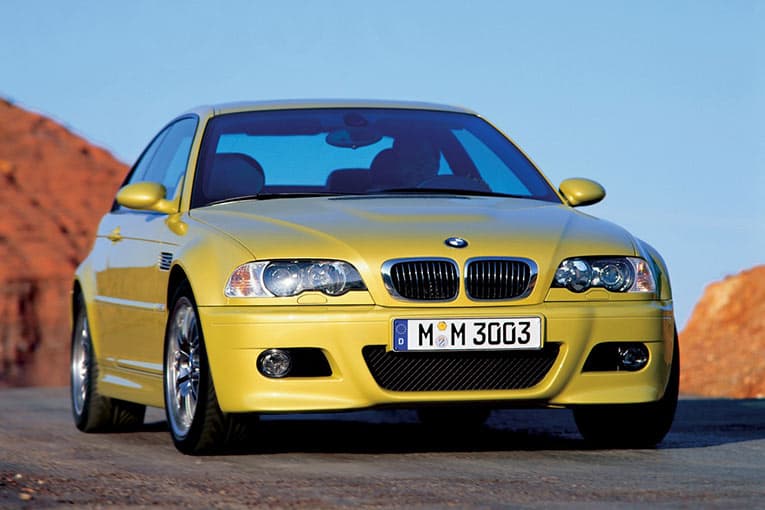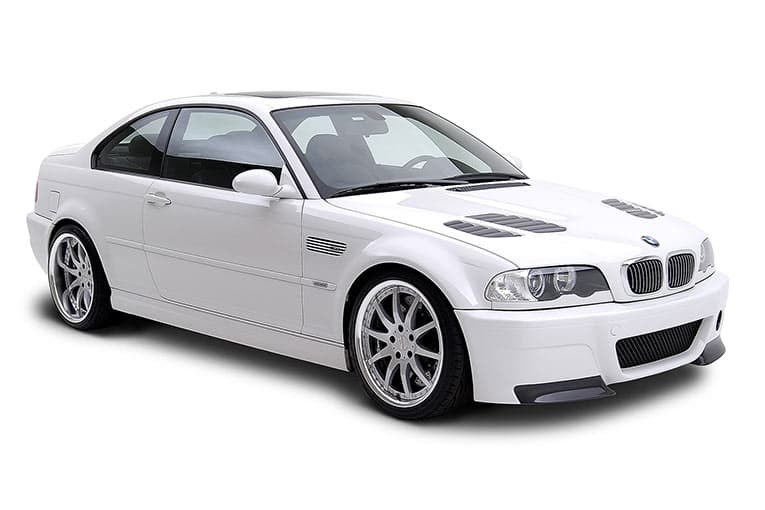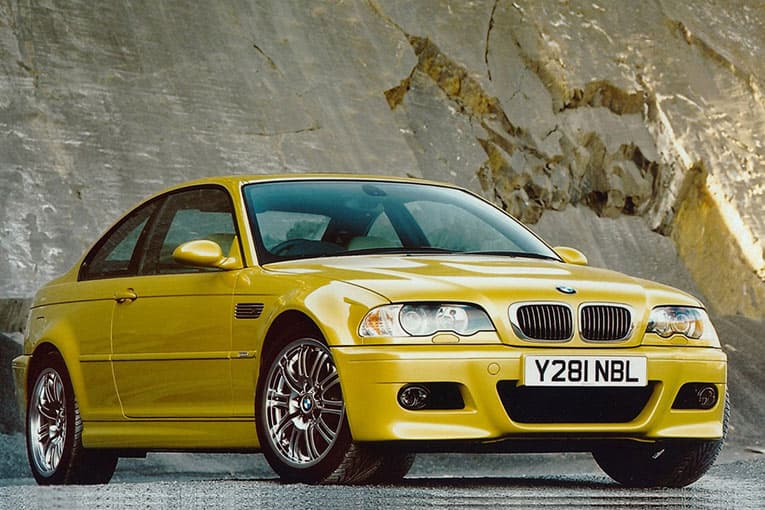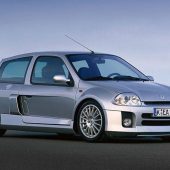E46 M3 was unveiled as a show car at the Frankfurt Motor Show in September 1999. Six months later, it celebrated a world premiere at the Geneva Motor Show. The third M3 was very powerful, wide and yet elegant. Thanks to a special front apron with integrated fog lamps and large cooling air intakes, it presented a significantly different profile to all other models in the BMW 3 Series. The engine compartment lid made of aluminium was curved in the centre, forming a power dome to create space for the M3 engine. The side profile of the M3 body including the wheel arches had undergone an increase in width of 20 millimetres, with air intakes and M3 badge in the front side panels. This beefy appearance was a visible consequence of aerodynamic optimization and an attribute creating a profile distinct from that of the 3 Series coupe. It was accompanied by appropriately beefy wide wheels in the format 225/45 ZR 18 at the front and 255/40 ZR 18 at the rear.
The impressive visual appearance of the M high-performance athlete was underscored by aspherical M outside mirrors, side sill trims and an aerodynamically optimised rear apron with rear spoiler lip. Any driver who was still unaware of which car had overtaken them was left in no doubt when they saw the four tailpipes of the twin-chamber exhaust system that it was a member of the M family of automobiles. Sports seats developed in-house with outstanding ergonomic characteristics provided an impressive combination of lateral support and unrestricted capability for travelling long distances. Apart from the diverse electrical adjustment options at all levels, adjustment of the reclining width was also supplied as a special.

New six-cylinder with more power and torque
People had expected no less. The heart of the new M3 was again an inline six-cylinder engine, the classic BMW power unit. Like its predecessor, this completely new engine offered lots of torque, even more power and all this for relatively low petrol consumption and low exhaust values. The M3 engine generated the impressive power of 343 hp (252 kW) from displacement of precisely 3246 cubic centimetres at an engine speed of 7900 rpm. The maximum torque achieved 365 newton metres at 4900 rpm. This yields a specific power of 105 hp for every litre, a value that has only been achieved by a few high-performance sports cars in the world not fitted with a turbocharger.
The highlights of the engine included a friction optimised cylinder head with cam follower valve timing. The double VANOS variable timing familiar from the other M models was further optimised. Electronic throttle valve control was responsible for actuating the six individual throttle valves. It communicated directly with the MSS 54 engine control unit specially developed for the M3. This multiprocessor system has two 32 bit microcontrollers and two timing coprocessors and computing power of 25 million calculations per second. However, the main goal of developing the new M3 engine was not geared simply to the generation of torque at all costs. The primary objective was to generate thrust as an indication of optimum handling of the available potential power. Thrust is mainly based on the exceptionally high torque of this engine combined with a relatively short final drive ratio. The available power could be converted into acceleration much more efficiently than in engines rotating at a lower speed. And this held over the entire range of speeds. In addition, the radial force-controlled oil siphoning guaranteed reliable lubrication and cooling for the engine in journeys with hairpin bends and manoeuvres involving heavy braking.

A few more statistics provide in indication of the athletic performance. The M3 accelerates from a standing start to 100 km/h in just 5.2 seconds. It took this car just 5.4 seconds to accelerate from 80 to 120 km/h in fourth gear. A special switch, the M Driving Dynamic Control, also allows drivers to select between sporty and high-comfort engine response.
Variable M differential lock
This sophisticated but powerful performance curve can be effortlessly transferred to the road with the six-speed manual gearshift. The variable M differential lock being used for the first time in the M3 provided efficient support. Differential locks can distribute different levels of tractive force individually to the rear drive wheels, depending on which wheel currently has the best traction. The special feature of the variable M differential lock was that it recorded the different rotational speeds rather than the different torque of the left-hand and right-hand rear wheels as in conventional systems. The difference in rotational speeds was compensated by the limited-slip system containing viscose oil so that adequate forward thrust was provided. This system provided a locking effect from 0 to 100 percent. This offered the M3 driver tangible benefits when starting off from difficult situations, and on sporty driving round hairpin bends. The M sports chassis of the M3 was put to the test many times in international motor sport and underwent further development. The chassis ensured outstanding roadholding and this automobile was also defending the endorsement of “Best Handling Car”. The engineers at BMW M implemented a lot of ideas to ensure that the car was capable of rising to the challenge of all types of handling limits: a high level of stiffness and minimising of the unsprung suspension components combined with a directness in performance unrivalled in this class. Lots of power also demanded excellent braking force. That’s why the M3 was given a robust high-performance braking system with floating compound brakes and perforated brake discs.

M3 Convertible
The new M3 Coupé had hardly been launched successfully when a second attractive version was making waves: the new M3 Convertible, an open-top sports four-seater in the premium class was launched on the marketplace in spring of 2001. Although this car was identical with the M3 Coupé down to the A-pillar, it exuded a high level of independence. The distinctive belt line and the character of a convertible made the car appear even wider and more powerful, the overall impression conveyed by the M3 Convertible was more muscular, flatter and broader. Naturally, all the typical M characteristics were integrated within the M3 Convertible, such as a powerful 343 PS/252 kW high-revving naturally aspirated engine, a perfectly tuned M chassis, the variable M differential lock, M high-performance brakes and the independent M design elements with the familiar qualities of the 3 Series Convertible. Other features included sports seats with power adjustment and integrated seat-belt system, as well as a variable folding-top compartment and a high level of safety achieved through maximally rigid body stiffness and a standard rollover protection system. The interior atmosphere was even more luxurious than the previous model – already a major success in a small niche market. And the M3 Convertible with its top speed of 250 km/h had awesome power. It took just 5.5 seconds for it to sprint from a standing start to 100 km/h, and required only 5.9 seconds to accelerate from 80 to 120 km/h in fourth gear. Average consumption was just 12.1 litres for every 100 kilometres.










